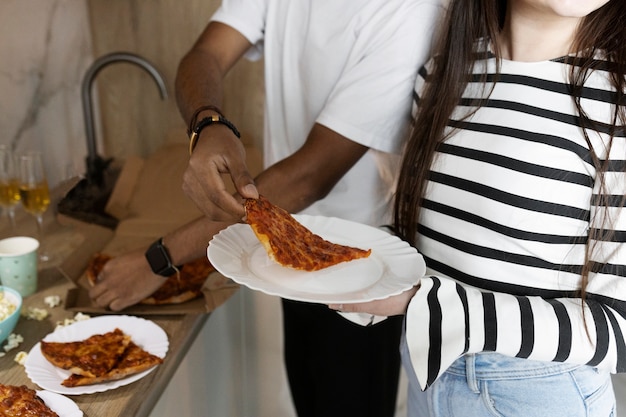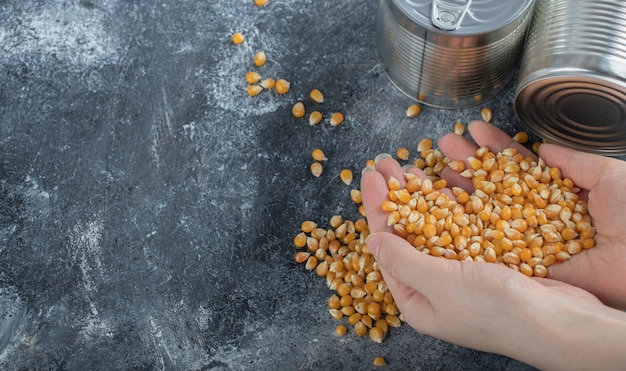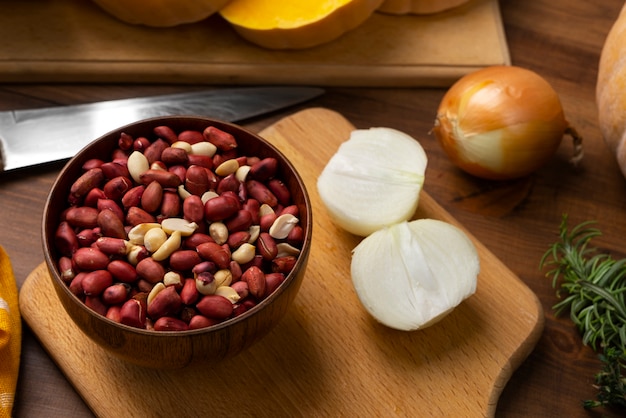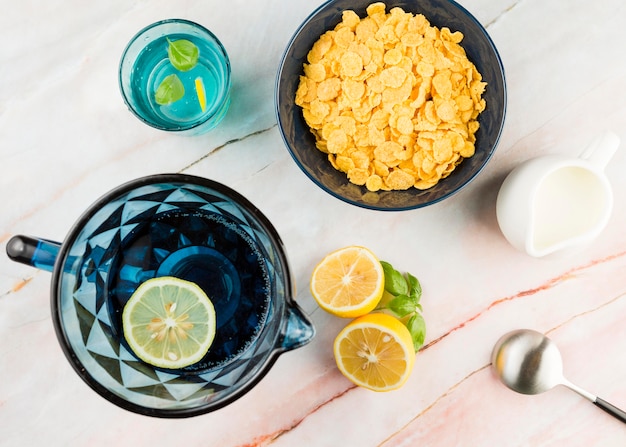I've always loved beans. They're versatile, nutritious, and can be the star of so many delicious meals. But let's be honest, cooking beans can be a bit of a mystery, especially when it comes to figuring out how long to cook them. You don't want to end up with a mouthful of hard, uncooked beans, do you? That's why I'm here to share my bean-cooking wisdom and guide you through the process.
This guide will take you on a journey through the world of beans, from choosing the right beans to mastering the art of cooking them to perfection. We'll explore different types of beans, their recommended cooking times, and various cooking methods. I'll even throw in some handy tips and tricks I've learned along the way. So, grab a cuppa, get comfy, and let's dive into the wonderful world of beans together.
(Part 1) The Foundations of bean cooking

Before we get into the specifics of bean types and cooking times, let's lay down the essential groundwork. Consider this your bean-cooking primer.
1.1 Selecting the Perfect Beans
The foundation of any great bean dish starts with quality beans. Look for beans that are firm, plump, and have a uniform colour. Avoid any beans that are cracked, discoloured, or have holes in them. These are signs of damage and might not cook properly.
I've learned that beans are like wine; they have personalities. Some beans are known for their creamy texture, while others are firmer and hold their shape. Choosing the right bean for your recipe is key to achieving the desired flavour and texture.
1.2 The Importance of Soaking
soaking beans is a crucial step that many people overlook. It makes a huge difference in both texture and cooking time. Soaking softens the beans, making them cook more evenly and reducing the risk of them becoming hard and uncooked. I usually soak my beans overnight, but a shorter soak of 2-4 hours can work in a pinch. The most important thing is to avoid skipping it altogether, especially for dried beans.
1.3 The Right Pot for the Job
You need a pot that can handle the job. I prefer a large, heavy-bottomed pot, as it helps distribute heat evenly and prevents the beans from sticking to the bottom. This is especially important when cooking beans, as they can be quite delicate and tend to stick if the pot isn't well-suited.
A pressure cooker can be a great option for those who want to speed up the cooking process. However, I find that the traditional method, cooking beans on the stovetop, gives me more control and allows me to create a more nuanced flavour.
1.4 The Magic Ratio: Bean to Water
The ratio of beans to water is crucial for achieving perfectly cooked beans. I typically use a 1:3 ratio, meaning for every cup of beans, I use three cups of water or stock. This ensures that the beans are fully submerged and have enough liquid to cook properly. You can always adjust the ratio depending on the type of beans you are using and the consistency you prefer.
(Part 2) A Bean Family Portrait: Different Types, Different Cooking Times

Let's get into the heart of the matter: the different types of beans and their recommended cooking times. Remember, these are just general guidelines, and you should always check the beans for tenderness before serving.
2.1 The All-American Kidney Bean
kidney beans are a classic for a reason. They're perfect for chilli, soups, salads, and so many other dishes. They have a firm texture and a mild, slightly sweet flavour. After soaking overnight, you can expect to cook them for about 1-1.5 hours until they reach that perfect tenderness.
2.2 black beans: A Flavorful Staple
Black beans are another favourite. They're often used in Mexican and Latin American cuisine, adding a rich, earthy flavour. They have a firmer texture and a slightly nutty flavour. Their cooking time is similar to kidney beans, typically 1-1.5 hours after soaking.
2.3 pinto beans: The Versatile Choice
Pinto beans are a great option for both savoury and sweet dishes. They have a creamy texture and a mild, nutty flavour, making them perfect for burritos, tacos, and dips. They take about 1-1.5 hours to cook after soaking.
2.4 Chickpeas: A Culinary Chameleon
Chickpeas, also known as garbanzo beans, are a culinary chameleon. Their nutty flavour and versatility make them a star in salads, curries, and dips. They typically take about 1-1.5 hours to cook after soaking.
2.5 cannellini beans: The Italian Delight
Cannellini beans, with their creamy texture and mild flavour, are a staple in Italian and french cuisine. They're perfect for soups, stews, and salads. They generally take around 1-1.5 hours to cook after soaking.
2.6 butter beans: Creamy and Sweet
Butter beans, also known as Lima beans, have a creamy texture and a sweet, buttery flavour. They're delicious in salads, stews, and soups. They usually take about 1-1.5 hours to cook after soaking.
2.7 Navy Beans: The Classic Baked Bean
Navy beans are known for their firm texture and mild flavour. They're a classic choice for baked beans and soups. They take about 1-1.5 hours to cook after soaking.
2.8 Fava Beans: A Mediterranean Treat
Fava beans have a slightly sweet and nutty flavour, making them popular in Mediterranean and Middle Eastern cuisine. They usually take about 1-1.5 hours to cook after soaking.
2.9 Broad Beans: A Subtle earthy flavor
Broad beans have a slightly sweet and earthy flavour. They're great in salads, soups, and stews. They usually take about 1-1.5 hours to cook after soaking.
2.10 Lentils: Quick and Easy
Lentils are a quick and easy option, often not requiring soaking. They cook in about 20-30 minutes. There are various types of lentils, each with slightly different cooking times, so check the package instructions for specific details.
(Part 3) Finding the Right Cooking Method: Stovetop, Oven, or slow cooker?

Now that we've explored the different types of beans and their cooking times, let's delve into the methods for cooking them. You can cook beans on the stovetop, in the oven, or even in a slow cooker.
3.1 The Stovetop Method: A Classic Approach
This is my go-to method for cooking beans. It's simple, reliable, and allows for more control over the cooking process. Simply bring the beans and water to a boil, then reduce the heat to a simmer and cook until the beans are tender. A pinch of salt added to the water enhances the flavour, and a bay leaf adds a lovely aroma.
3.2 The oven method: A Slow and Steady Approach
You can also bake your beans in the oven, which is a good option if you want to cook them alongside other ingredients like vegetables, herbs, or spices. Preheat your oven to 350°F (175°C), spread the soaked beans in a baking dish with enough water to cover them, and bake for about 1-1.5 hours, checking for tenderness halfway through.
3.3 The slow cooker method: Hands-Off Cooking
The slow cooker is a fantastic choice if you prefer a hands-off approach. Simply combine the beans, water, and any seasonings in your slow cooker and cook on low heat for 6-8 hours, or on high heat for 3-4 hours. The slow cooker is excellent for tenderizing beans and infusing them with deep flavour.
(Part 4) Mastering the Art of Bean Cooking: Tips and Tricks
Here are some tips and tricks I've learned through years of bean cooking. These little details can make a big difference in achieving perfect beans every time.
4.1 The Salt Situation: When to Season
Adding salt at the beginning of cooking can toughen the beans. It's best to wait until the beans are almost cooked and then add a pinch of salt to season them. This helps prevent them from becoming too tough and allows the beans to absorb the salt more evenly.
4.2 The Frothy Foam: A Sign of Cooking
You might notice a foamy layer forming on top of the beans during cooking. This is perfectly normal and can be easily skimmed off with a spoon. Just don't let it get too thick, as it can make the beans taste bitter.
4.3 The Timing is Everything: Checking for Tenderness
Beans are ready when they're tender and easily mashed with a fork. They should still hold their shape, but they should be soft enough to be comfortable to eat. If they're not yet tender, continue cooking them until they reach the desired consistency. Once they're cooked, drain them and use them in your favourite recipes.
4.4 Beyond the Basics: Adding Flavour
Don't be afraid to get creative with your bean cooking. You can add herbs, spices, and other ingredients to enhance the flavour. I love adding a bay leaf, a sprig of thyme, or a few garlic cloves to my beans.
(Part 5) bean storage: Keeping Your Beans Fresh
Sometimes, we cook more beans than we need. No problem! You can store your leftover cooked beans for later use. Here's how:
5.1 Refrigerating Cooked Beans: Short-Term Storage
You can store cooked beans in the fridge for up to 5 days. Transfer them to an airtight container and store them in the refrigerator. They'll stay fresh and ready for use in your next meal.
5.2 Freezing Cooked Beans: Long-Term Storage
You can also freeze cooked beans for longer storage. I typically freeze them in individual portions, making it easy to grab a handful when I need them. They can be frozen for up to 3 months. Remember to defrost them in the refrigerator before using them.
(Part 6) bean recipes: Inspiration for Your Next Meal
Now that you've got the bean basics down, it's time to get creative in the kitchen. Here are a few of my favourite bean recipes to inspire your next meal.
6.1 Classic Bean Chilli: A Comforting Favourite
This is a classic comfort food that's super easy to make. Brown some ground beef or turkey in a pot, then add chopped onions, peppers, garlic, and your favourite spices. Add in some kidney beans, black beans, and diced tomatoes. Let it simmer until the flavours have melded and the chilli has thickened. Serve with some rice, sour cream, and shredded cheese.
6.2 Creamy bean soup: A Hearty and Satisfying Meal
This is a hearty and satisfying soup that's perfect for a chilly day. Saute some chopped onions, celery, and carrots in a pot, then add in some cooked beans (like cannellini or butter beans), vegetable stock, and a splash of milk or cream. Simmer until the soup is thickened, then season to taste. Top with fresh herbs and a swirl of cream.
6.3 Spicy black bean salad: A Summertime Treat
This is a fresh and flavourful salad perfect for a summer barbecue. Combine cooked black beans, chopped tomatoes, red onion, cilantro, lime juice, and a touch of chili flakes. Serve it with some tortilla chips or cornbread.
6.4 Mediterranean chickpea salad: Light and Refreshing
This is a light and refreshing salad that's packed with flavour. Combine cooked chickpeas, chopped cucumber, red onion, parsley, lemon juice, and olive oil. Top with crumbled feta cheese and a sprinkle of sumac.
6.5 Hearty lentil curry: A Flavour-Packed Meal
This is a flavour-packed curry that's perfect for a cold night. Saute some onions, garlic, and ginger in a pot, then add in lentils, coconut milk, curry powder, and your favourite vegetables. Simmer until the lentils are cooked through and the curry has thickened. Serve with rice or naan bread.
(Part 7) Bean Trivia: Fun Facts About These Versatile Legumes
Beans are more than just a healthy and delicious addition to your meals. They're fascinating legumes with a rich history and surprising qualities. Here are a few fun facts you might not know.
7.1 Beans: Ancient Food
Beans have been a staple food for thousands of years. Archaeological evidence suggests that beans were first cultivated in the Americas as far back as 7000 BC.
7.2 Beans: A Global Food
Beans are grown and consumed all over the world. From the black beans in Mexican cuisine to the chickpeas in Middle Eastern dishes, beans play a central role in many culinary traditions.
7.3 Beans: The Powerhouse of Nutrition
Beans are packed with nutrients. They're a good source of protein, fiber, iron, and folate. They're also low in fat and calories, making them a healthy choice for those who are looking to manage their weight.
7.4 Beans: The Environmentally Friendly Choice
Beans are considered a sustainable food source. They require less water and land to grow than other protein sources, such as beef and chicken.
(Part 8) FAQs: Your Bean-Cooking Questions Answered
Now that you've got a good handle on the basics of bean cooking, you might have a few questions. Don't worry, I've got you covered. Here are some frequently asked questions about beans, and I'll provide detailed answers.
8.1 What are the benefits of soaking beans?
Soaking beans offers several benefits:
- Softens beans: This makes them cook more evenly and reduces cooking time.
- Reduces gas and bloating: Soaking helps remove some of the oligosaccharides, sugars that can cause gas and bloating.
- Reduces antinutrients: Soaking helps reduce the level of antinutrients, compounds that can interfere with the absorption of nutrients.
8.2 How do I know if my beans are cooked properly?
The best way to test if your beans are cooked properly is to use a fork. The beans should be tender enough to be easily mashed with a fork. They should still hold their shape but be soft enough to be comfortable to eat. If the beans are still firm and hard to mash, they need to cook a bit longer.
8.3 Can I use canned beans instead of dried beans?
Absolutely! Canned beans are a great convenience option, and they're already cooked. You can use them directly in recipes, or you can rinse them and drain them to remove excess salt and sodium. However, canned beans are often lower in fiber and nutrients than dried beans.
8.4 What should I do if my beans are too salty?
If you find that your beans are too salty, you can try adding some more water or broth to the pot and letting it simmer for a few more minutes. This will help to dilute the saltiness. You can also try adding a pinch of sugar to help balance out the saltiness.
8.5 Are there any ways to reduce the gas associated with eating beans?
Beans are known for causing gas and bloating in some people. To reduce the gas associated with beans, try soaking them for longer, or even boiling them for a few minutes before cooking them. You can also try adding a pinch of baking soda to the cooking water. Ultimately, it's about finding what works best for your body.
(Part 9) Bean Cooking: A Journey of Flavour and Discovery
Bean cooking is about more than just following a recipe. It's about experimenting, exploring flavours, and discovering the magic of these versatile and delicious legumes. Get out there, embrace the world of beans, and enjoy the culinary journey! Happy bean cooking!
Everyone is watching

Perfect Rice Every Time: The Ultimate Guide to Cooking Rice
Cooking TipsAs a self-proclaimed foodie, I've always been a bit obsessed with rice. It's the foundation of countless cuisi...

The Ultimate Guide to Cooking Asparagus: Tips, Techniques, and Recipes
Cooking TipsAsparagus. The mere mention of this spring delicacy conjures up images of vibrant green spears, crisp and burs...

Ultimate Guide to Cooking the Perfect Thanksgiving Turkey
Cooking TipsThanksgiving. Just the word conjures up images of overflowing tables laden with delicious food, the scent of r...

Prime Rib Roast Cooking Time Chart: Per Pound Guide
Cooking TipsPrime rib roast. Just the name conjures images of lavish dinners, crackling fires, and hearty laughter. It’s ...

Can You Cook Spaghetti with Gasoline? (The Shocking Truth)
Cooking TipsWe've all seen those crazy internet trends. You know, the ones that make you wonder, "Did someone actually try...
